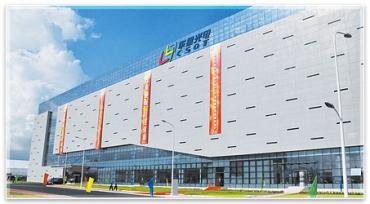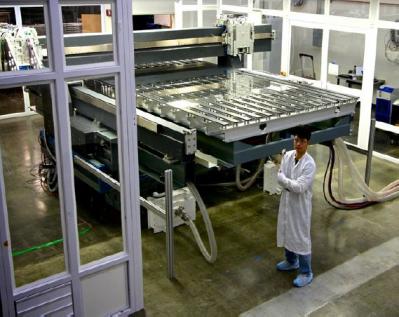OLED ink jet printing: introduction and market status - Page 11
ETNews: SDC is building a QD-OLED TV pilot production line
In February 2018 it was first reported that Samsung Display is developing TV panels based on hybrid quantum-dots and OLED architecture (QD-OLED). Samsung later confirmed it is developing such technology, but with no immediate plans to commercialize it.

ETNews now reports that Samsung is now working to establish a pilot 8-Gen line for QD-OLED production. ETNews says that Samsung is collaborating with both Canon Tokki and Kateeva to develop the production equipment - apparently the OLED layers will be evaporated using Canon's machines while the QD filters will be deposited using ink-jet printing equipment made by Kateeva. Samsung aims to finalize the production line by the second half of 2019.
CSoT details its OLED ink-jet printing plans, collaborates with Kateeva, Sumitomo, Merck, DuPont and Tianma
Last month CSoT (TCL) announced plans to establish a 11-Gen LCD+OLED TV fab in Shenzhen, China. Details on the OLED part of that fab were not given, but now we have some updates following the company's investor day.

The new fab will use Oxide-TFT backplanes, and it turns out that the OLED part of the fab will also use the 11-Gen substrates (which may be cut for the actual OLED front plane deposition). Out of the entire capacity of 90,000 monthly substrates, the OLED line will use 20,000 substrates. The fab will start mass production in 2021.
BOE demonstrates its first inkjet-printed OLED prototype at SID 2018
China's largest display maker BOE Display has an active OLED ink-jet printing project, and according to reports the company is establishing an R&D production line (in Hefei) that uses Kateeva's inkjet deposition equipment.
At SID 2018, BOE demonstrated a printed OLED panel for the first time. Surprisingly this is a small mobile OLED display - a 5.5" FHD (400 PPI) flexible AMOLED. It is usually assumed that inkjet printing is limited to around 200 PPI, and so only useful to large area panels (such as TVs or monitors). JOLED's 21.6" 4K printed OLEDs have a PPI of 204, for example. In 2017 Korea-based Unijet's president said that Inkjet printing could reach up to 550 PPI in 2020 by using next-generation laser-droplet technologies.
Pixelligent raised $7.6 million, is working with Kateeva to adopt its materials for OLED inkjet printing
US-based high-index material maker Pixelligent Technologies announced it raised $7.6 million in a new funding round that will help the company to further drive its product commercialization and accelerate global customer adoption.
This round was led by the Abell Foundation, and included other Baltimore-based investors. This found also included strategic investments from Kateeva and Japan-based advanced material producer Tokyo Ohka Kogyo.
Juhua Printing developed an ink-jet printed 31" 4K OLED panel
TCL announced that Guangdong Juhua Printing Display Technology developed a 31" 4K OLED display. According to the report from Korea, Juhua Printing is using 6-Gen substrate which are cut in half for the organic layer ink-jet deposition which is done at 4.5-Gen.
TCL hopes to finalize the inkjet mass-production technology development by 2019, on 11-gen substrate.
DSCC: the OLED material market will reach $2.56 billion in 2022
Display Supply Chain Consultants (DSCC) says that OLED material revenues grew 43% to reach $869 million in 2017. DSCC expects the OLED material market to grow at a 24% CAGR until 2022, when the market will reach $2.56 billion.

The small/medium display market accounts to about 59% of the total OLED material market, and this will continue until 2022. For the TV market, DSCC expects ink-jet printing to enable producers to make lower the material costs of OLED TV production, and OLED TV materials will grow at a rate of 23%, from $344 in 2017 to $963 million in 2022.
OLED Ink-jet printing market situation, early 2018
Many OLED producers believe that Ink-Jet printing of OLED emissive materials is the best way to achieve lower-cost OLED TV production, and to enable OLEDs to compete in the medium part of the TV market. Ink-Jet printing is an efficient process (less material waste compared to evaporation) and it can be very quick as well. The main drawbacks of inkjet are the limited resolution and the need for soluble emissive materials which are less efficient compared to evaporation ones.

A Kateeva OLED ink-jet printing system
These challenges are being overcome, and it seems that at least four groups (in Korea, Japan and China) are charging forward towards mass production of ink-jet printed OLEDs. Ink-jet printer makers and soluble material suppliers are also optimistic ink-jet printing commercialization will soon be here as the material performance gap is diminishing.
Here's Asus' 21.6" ink-jet printed OLED Monitor on video
Earlier this month Asus introduced a new OLED monitor, the 21.6" 3840x2160 (204 PPI) ProArt PQ22UC, which uses a ink-jet printed OLED panel produced by JOLED. The following video shows this new laptop which is said to have a remarkable image quality and a portable design:
Asus did not yet reveal the price of its first OLED monitor, but it did say it will ship by the spring of 2018. JOLED announced a few weeks ago that it started commercial production of 21.6" ink-jet printed 4K OLED panels. JOLED's production capacity is not large as the company is still using a pilot-scale line, but JOLED is seeking to raise $900 million to support its plan to start mass producing OLEDs in 2019.
JOLED supplies the 21.6" 4K OLEDs used by Asus in its new OLED monitor
Yesterday we posted on a new OLED monitor, the Asus ProArt PQ22UC with a 21.6" 3840x2160 (204 PPI) OLED panel. It turns out that this panel is produced by JOLED.

This is very interesting news. JOLED indeed announced a few weeks ago that it started commercial production of 21.6" ink-jet printed 4K OLED panels, and it is great to see a product launched so quickly. JOLED's production capacity is not large, the company is still using a pilot-scale line, but it's likely that Asus is not expecting to sell many units of this high-end OLED monitor.
Denso may invest $450 million in JOLED to help it achieve OLED mass production
Following JOLED's announcement that it started commercial shipments of its 21.6" 4K OLED panels for use in medical monitors in its low-volume 4.5-Gen ink-jet printing production line, it was reported that the Japanese display maker is seeking to raise $900 million to support its plan to start mass producing OLEDs in 2019.

Reuters reports today that Denso Corp (an automobile parts producers) is considering a $440 million investment in JOLED. Earlier reports from Japan claimed the JOLED received funding commitments from Sony and Panasonic, with both Sumitomo Chemical (who supplies its P-OLED materials to JOLED) and Screen Holdings (who supplies its equipment to JOLED) are likely to take part in the financing round as well. Each of these four companies will invest between $45 to $90 million.
Pagination
- Previous page
- Page 11
- Next page

